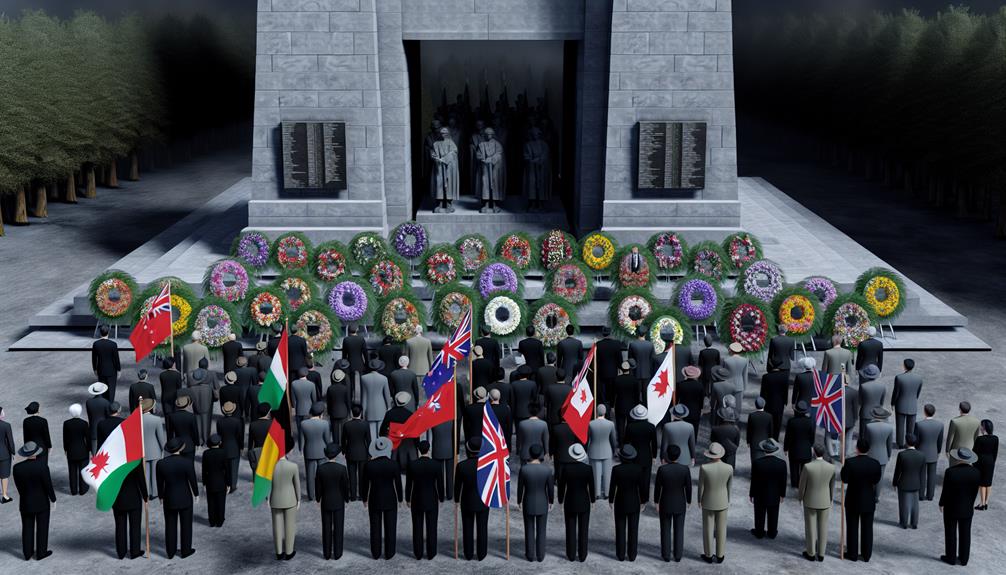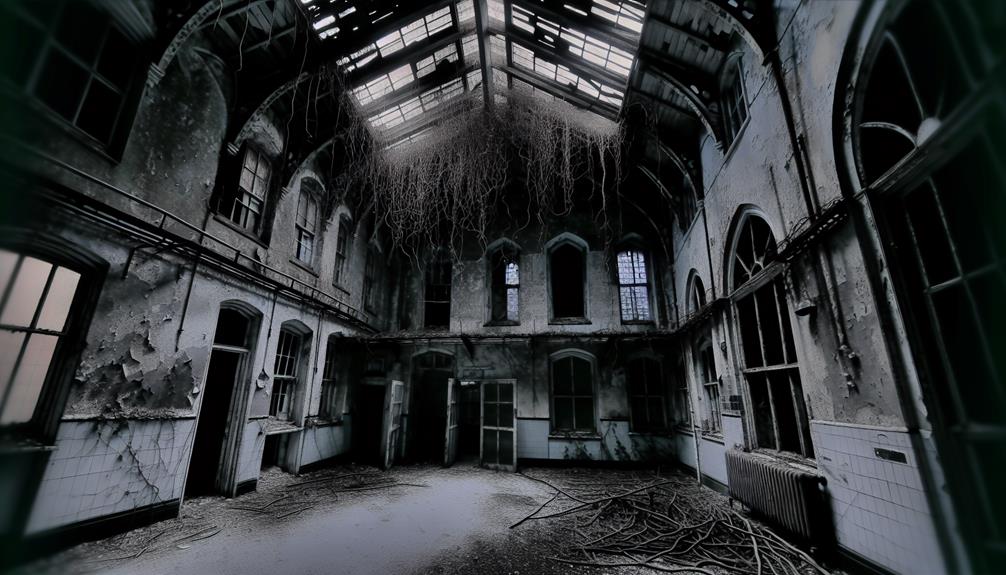The Cenotaph, a stoic monument evoking reverence and remembrance, encapsulates the essence of sacrifice and national unity. Its unassuming grandeur and timeless design invite contemplation and introspection, serving as a poignant reminder of the price of freedom. Beyond its physical presence, the Cenotaph embodies a profound symbolism that transcends generations, prompting us to ponder the enduring significance of collective memory and shared heritage. As we stand before this solemn structure, we are compelled to reflect on the past and consider the implications for the present and future.
Key Takeaways
- Simple elegance conveys solemnity and respect.
- Centralized design symbolizes national unity.
- Timeless structure ensures enduring relevance.
- Monument serves as sacred space for reflection.
- Symbol of strength, sacrifice, and historical significance.
Origins of the Cenotaph
The origins of the Cenotaph can be traced back to the aftermath of World War I, where the concept of an empty tomb serving as a symbolic memorial emerged as a poignant tribute to the fallen soldiers. This monument, originally revealed in Whitehall, London, was designed by Sir Edwin Lutyens and introduced on Armistice Day in 1920. The architectural evolution of the Cenotaph reflects the historical context of the time, marked by tremendous loss and a collective desire to honor those who made the ultimate sacrifice.
During the early 20th century, the devastation of World War I left a deep imprint on societies across the globe. The Cenotaph, with its simple yet powerful design, became a focal point for national mourning and remembrance. The evolution of its architecture from a temporary wooden structure to the iconic Portland stone monument we see today symbolizes the enduring memory of those who perished in the war.
The historical context surrounding the Cenotaph underscores its significance as a symbol of unity and reverence for the fallen. As the monument evolved over the years, it continued to serve as a poignant reminder of the sacrifices made during wartime. The architectural evolution of the Cenotaph mirrors the evolving attitudes towards remembrance and commemoration, making it a timeless proof to the enduring legacy of those who gave their lives for their country.
Architectural Significance
Reflecting the principles of neoclassical architecture, the Cenotaph stands as a solemn tribute to the enduring memory of those who sacrificed their lives in war. The historical context in which the Cenotaph was revealed is essential to understand its architectural significance. Designed by Sir Edwin Lutyens and introduced in 1920, the Cenotaph was initially created as a temporary structure for the Peace Day celebrations following World War I. However, its overwhelming popularity led to its permanent reconstruction in stone the following year.
The architectural features of the Cenotaph are emblematic of its purpose. Its simple and austere design consists of a large, empty tomb atop a rectangular base. This minimalist approach was intentional, aiming to emphasize the solemnity and dignity of remembrance rather than grandeur. The use of Portland stone provides a sense of permanence and timelessness, symbolizing the enduring memory of the fallen.
The Cenotaph's architectural significance lies in its ability to evoke a sense of reverence and contemplation. Its clean lines and geometric form exude a sense of order and harmony, creating a space for collective mourning and reflection. By blending classical elements with modern simplicity, the Cenotaph stands as a poignant reminder of the sacrifices made during times of conflict, ensuring that the memory of the fallen will never fade.
Symbolism of the Design
Embodying layers of symbolic meaning through its architectural elements, the Cenotaph's design intricately conveys profound messages of remembrance and sacrifice. The monument stands as a sacred space, a visual tribute to the valor and loss experienced in times of war. Here are four key aspects of the Cenotaph's design that contribute to its rich symbolism:
- Simple Elegance: The Cenotaph's clean, unadorned lines and stark silhouette symbolize the solemnity of remembrance and the purity of sacrifice. Its simplicity allows visitors to focus entirely on the act of commemoration without distractions.
- Centralized Structure: Placed at the heart of Whitehall, the Cenotaph's centralized location symbolizes the unity of the nation in honoring its fallen heroes. It serves as a focal point for collective mourning and reflection.
- Absence of Figurative Representation: The lack of figurative sculptures or inscriptions on the Cenotaph emphasizes a universal message of remembrance that transcends individual identities or ranks. This absence invites all visitors to project their meanings onto the monument.
- Timeless Design: The Cenotaph's geometric form and austere materials give it a timeless quality, ensuring that its message of remembrance remains relevant across generations. This timelessness reinforces the enduring nature of sacrifice and the continuity of honoring the fallen.
Ceremonial Importance
A pivotal aspect underscoring the significance of the Cenotaph lies in its ceremonial importance, serving as a focal point for national commemorations and solemn tributes. The Cenotaph's historical significance is deeply intertwined with its role in upholding cultural traditions that honor the sacrifices of servicemen and women. Erected as a symbol of remembrance, the Cenotaph stands as a testament to the nation's collective memory of those who gave their lives in war.
The Cenotaph commands public reverence and emotional resonance during key ceremonial events such as Remembrance Sunday and Armistice Day. These occasions draw citizens together in a shared moment of reflection, fostering a sense of unity and gratitude for the sacrifices made for the country's freedom. The Cenotaph's presence at these events not only underscores its ceremonial importance but also reinforces its role as a tangible link to the past, connecting present generations with the memories of fallen heroes.
Through its enduring ceremonial significance, the Cenotaph continues to serve as a powerful symbol of national identity and collective memory. Its ability to evoke emotions of respect, gratitude, and remembrance underscores its role in honoring the past while shaping the future. In this way, the Cenotaph stands as a beacon of cultural tradition and historical significance, perpetuating the values of sacrifice and service for generations to come.
Commemorative Events
The Cenotaph's role in upholding cultural traditions and honoring sacrifices seamlessly extends to the organization and execution of commemorative events that pay tribute to the servicemen and women who made the ultimate sacrifice. These events hold significant importance in the collective memory of a nation, ensuring that the sacrifices of past generations are never forgotten.
- Memorial services: The Cenotaph serves as a focal point for solemn memorial services, especially on Remembrance Day, where people gather to honor and remember the fallen heroes who fought for their country. These services often include moments of silence, wreath-laying ceremonies, and speeches to commemorate the sacrifices made.
- War memorials: Surrounding the Cenotaph are various war memorials dedicated to specific conflicts or military units. These memorials serve as poignant reminders of the bravery and dedication shown by the soldiers who fought in those wars, allowing visitors to pay their respects and reflect on the impact of war.
- Veterans Day: In addition to Remembrance Day, the Cenotaph plays an important role in Veterans Day commemorations. This day is dedicated to honoring all veterans, living and deceased, who have served in the armed forces. The Cenotaph serves as a place where veterans can come together to remember their comrades and the sacrifices they made.
- Commemorative ceremonies: Throughout the year, various commemorative ceremonies are held at the Cenotaph to mark significant military events, anniversaries, or milestones. These ceremonies bring together veterans, serving military personnel, dignitaries, and the public to pay tribute to the sacrifices of those who served their country. The Cenotaph stands as a symbol of remembrance and gratitude during these solemn occasions.
Role in National Mourning
Playing a pivotal role in national mourning, the Cenotaph stands as a solemn symbol of remembrance and reverence for those who have made the ultimate sacrifice in service to their country. During times of collective grief, the Cenotaph serves as a focal point where the nation can come together to honor and mourn the fallen heroes. This iconic monument plays a vital role in fostering national unity by providing a physical space for people to gather and pay their respects, regardless of their background or beliefs.
The Cenotaph's significance in national mourning is deeply rooted in its ability to evoke a sense of shared sorrow and gratitude. As individuals stand before the monument, they are reminded of the sacrifices made by generations past, reinforcing the idea of a collective memory that transcends time and space. This shared experience of grief helps strengthen the bonds that unite a diverse nation, emphasizing the common values and ideals that bind its people together.
Moreover, the Cenotaph's role in national mourning extends beyond just honoring the fallen; it also serves as a poignant reminder of the cost of war and the importance of working towards a more peaceful future. By coming together at this symbolic site, individuals reaffirm their commitment to peace and solidarity, ensuring that the sacrifices of the past are never forgotten. In essence, the Cenotaph stands as a timeless tribute to the enduring spirit of remembrance and unity that defines a nation in mourning.
Political and Social Impact
With its prominent presence in the public sphere, the Cenotaph exerts a significant influence on the political and social landscape, shaping perceptions and fostering reflections on national identity and collective memory. The political and social impact of the Cenotaph is profound, serving as a poignant reminder of historical events and evoking a sense of national unity among the people.
- Symbol of Strength and Resilience: The Cenotaph stands as a symbol of the nation's strength and resilience, honoring the sacrifices made by those who fought for their country. It serves as a reminder of the challenges faced and overcome, instilling a sense of unity and pride in the collective history of the nation.
- Reflecting on Historical Significance: The Cenotaph's historical significance cannot be understated, as it represents a tangible link to the past and a tribute to the sacrifices of previous generations. By commemorating the fallen, it fosters a deep appreciation for the country's history and the struggles endured to secure a better future.
- Inspiring National Unity: Through ceremonies and events held at the Cenotaph, the monument plays an important role in inspiring national unity and solidarity. It brings people together to reflect on the shared history and values that bind them as a community, fostering a sense of belonging and identity.
- Shaping Collective Memory: The Cenotaph's presence in public spaces ensures that the memory of the sacrifices made in the past remains alive in the national consciousness. It helps shape collective memory by providing a physical focal point for remembrance and reflection, guaranteeing that future generations continue to honor and learn from the past.
Cultural Representation
An exploration of how the Cenotaph symbolically represents various cultural aspects reveals its multifaceted significance within the societal framework. As a piece of public art, the Cenotaph stands not only as a physical monument but also as a representation of collective memory and national identity. Its solemn design and historical significance serve as a poignant reminder of the sacrifices made during times of conflict, resonating deeply with individuals across different cultural backgrounds.
The Cenotaph's role as a symbol of historical significance is evident in its design and placement. Erected in Whitehall, London, the heart of the UK's governmental district, the Cenotaph serves as a focal point for national commemorations, further solidifying its importance in the country's cultural landscape. Its austere architecture and inscriptions bear witness to the nation's losses in war, creating a space for reflection and remembrance for people of all cultural backgrounds.
Moreover, the Cenotaph's representation of historical events transcends boundaries, making it a universal symbol of respect and honor for those who have served. Its presence at ceremonies and public gatherings underscores its role as a unifying force, bringing together individuals from diverse cultural backgrounds to pay their respects and acknowledge the shared history of sacrifice and service. In this way, the Cenotaph's cultural representation extends beyond its physical form, embodying the collective memory and values of a nation.
Restoration and Preservation Efforts
Efforts to restore and preserve the Cenotaph, a symbol of national significance and remembrance, have been meticulously planned and executed to uphold its historical integrity and guarantee its longevity for future generations. The conservation techniques employed and the community involvement in these restoration projects play a crucial role in maintaining the Cenotaph's status as a revered monument.
- Conservation Techniques: Preservation experts utilize cutting-edge conservation techniques to make certain that the Cenotaph's structure remains intact and free from deterioration. These methods include regular cleaning, repairing any damages, and applying protective coatings to shield the monument from environmental elements.
- Historical Significance: Every restoration effort is underpinned by a deep understanding of the Cenotaph's historical significance. By delving into the monument's past, preservationists can make informed decisions that honor its original design and purpose.
- Community Involvement: The engagement of the local community in restoration initiatives fosters a sense of ownership and pride in the Cenotaph. Through volunteering opportunities, educational programs, and fundraising events, residents actively participate in the preservation of this cherished symbol.
- Public Engagement: Public engagement initiatives, such as informational tours and outreach campaigns, raise awareness about the importance of the Cenotaph and its role in commemorating the nation's history. By involving the public in these efforts, the monument's significance is amplified, ensuring it remains a focal point of remembrance for generations to come.
Global Recognition and Influence
The Cenotaph's global recognition and influence are underscored by its profound impact on collective memory and historical narratives worldwide. This iconic monument, located in London, holds immense international recognition for its role as a symbol of remembrance and tribute to those who sacrificed their lives in conflict. Its historical significance transcends borders, resonating with nations that have experienced similar wartime losses and commemorating the shared sacrifices of countless individuals.
The Cenotaph's influence extends beyond its physical presence, shaping how societies remember and honor their fallen heroes. Countries around the world have erected cenotaphs modeled after the original in Whitehall, reflecting a universal understanding of the importance of honoring the past. These replicas serve as poignant reminders of the collective grief and gratitude felt globally for those who have served and died in wars.
Moreover, the Cenotaph's symbolism has been instrumental in fostering a sense of unity and solidarity among nations, emphasizing the common values of peace and remembrance. Its portrayal in various historical accounts and media further solidifies its status as a beacon of international recognition and reverence. As a result, the Cenotaph stands as a powerful reminder of the enduring impact of war on societies worldwide and the importance of preserving the memory of those who made the ultimate sacrifice.
Frequently Asked Questions
How Has the Design of the Cenotaph Influenced Modern Architecture?
The design of the cenotaph has greatly influenced modern architecture by serving as a catalyst for innovative structures and contributing to the architectural evolution.
Its minimalist and symbolic approach has inspired architects to explore new forms, materials, and meanings in their designs.
The cenotaph's emphasis on memorialization and reflection has left a lasting impact on contemporary architectural practices, encouraging a deeper connection between buildings and their societal, historical, and cultural contexts.
Are There Any Hidden Symbols or Messages Within the Cenotaph's Design?
In exploring the design of the Cenotaph, intriguing theories suggest hidden meanings within its structure. Architectural influence can be seen in the use of symmetrical lines and minimalist aesthetic, symbolizing unity and remembrance.
The deliberate choice of materials like Portland stone may hold significance, representing durability and strength.
While no conclusive evidence confirms hidden symbols, the Cenotaph's timeless design continues to spark curiosity and reverence, inviting further exploration into its possible deeper meanings.
How Do World Leaders Participate in Ceremonies at the Cenotaph?
World leaders from across the globe participate in ceremonies at the Cenotaph by laying wreaths as solemn tributes to the fallen soldiers. Their presence symbolizes unity and remembrance on an international scale. These leaders often stand together in a moment of silence, showcasing solidarity and respect for those who sacrificed their lives.
Through these actions, world leaders convey a powerful message of honor and gratitude towards the soldiers who fought for their nations.
What Unique Cultural Traditions Are Associated With the Cenotaph?
Throughout history, the Cenotaph has become a focal point for unique cultural traditions deeply rooted in remembrance and reverence. Architectural influence is evident in the somber elegance of the structure, symbolizing unity and respect.
Ceremonies at the Cenotaph highlight traditions such as the laying of wreaths, a poignant gesture embodying honor and memory. These cultural practices serve as a powerful reminder of sacrifice and solidarity, shaping the enduring symbolism of this iconic monument.
Has the Cenotaph Ever Been Relocated or Considered for Relocation?
The Cenotaph, a symbol of remembrance and national identity, has not been relocated since its establishment. Its historical significance as a monument honoring the fallen soldiers of World War I, and later expanded to include other conflicts, has solidified its place in the heart of the nation.
While there may have been discussions or considerations for relocation in the past, the enduring reverence and cultural importance attached to the Cenotaph have deterred any actual relocation efforts.
Conclusion
To sum up, the Cenotaph stands as a timeless beacon of remembrance, embodying the collective sacrifices of the past.
Like a steadfast lighthouse guiding ships through turbulent waters, the Cenotaph serves as a symbol of honor, respect, and unity for nations around the world.
Its enduring presence reminds us of the importance of preserving our shared history and fostering a sense of collective memory for future generations to come.


